Story by Li Jun and Yang Biyu. Reproduced with permission by Jiangxi Daily.
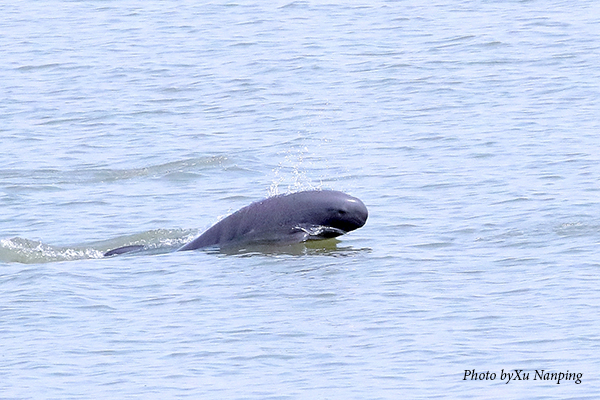
As the only member of the Living Lakes Network from China, Poyang Lake is Asia’s largest wintering ground for migratory birds. It also offers habitats and shelter for the Yangtze finless porpoise and many other rare and endangered species.
Due to the extreme drought weather event that started in July 2022 in the Yangtze River Basin, the lake has suffered the most severe water shortage crisis since the hydrological record for the lake was started in 1951. For a period of time, it even saw its surface area shrink by over 90 percent.
The extreme drought conditions in the lake have greatly reduced the living spaces for wild animals that inhabit the area. Are these animals still alright? As winter continues, we have set foot around the lake to listen to the stories about the harmonious coexistence of people that watch over the lake and the animals.
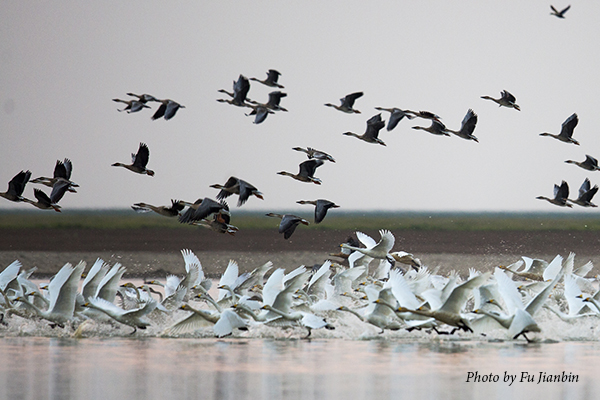
For the “smiling angel”
“Look! That is a Yangtze finless porpoise.” Braving the freezing wind penetrating people’s bones in December, we could hardly open our eyes as we moved forward in the waters around Piaoyatou, an area of the lake around Songmen Mountain. Mr. Pan, however, spotted the porpoise soon after it came into sight. Following the direction he pointed for us, we saw a porpoise leap out of the water. But it soon went out of sight, leaving only ripples.
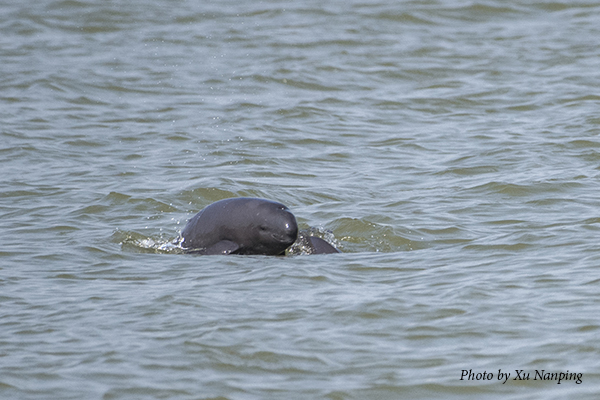
The full name of Mr. Pan is Pan Ximing. He is a member of the law enforcement team for fishing management in Yongxiu county. Since late September, he has been on duty in the area.
“When I came, I only wore a shirt with short sleeves. It has almost been 100 days,” he said.
The Yangtze finless porpoise has a very round head. The shape of its mouth makes people feel as if it were smiling. Because of this, it is often dubbed a “smiling angel.”
It is now the only cetacean living in the Yangtze River. It’s an important index species that can tell the achievements in Yangtze conservation and the health conditions of the river.
Poyang Lake is referred to as the “last fortress” for the Yangtze finless porpoise, as half of the species’ population inhabits the waterbody. Stretching for over 40 square kilometers, the Piaoyatou area is where experts spotted the porpoise multiple times. The severe shrinkage of Poyang’s surface area has posed a grave threat to the animal.
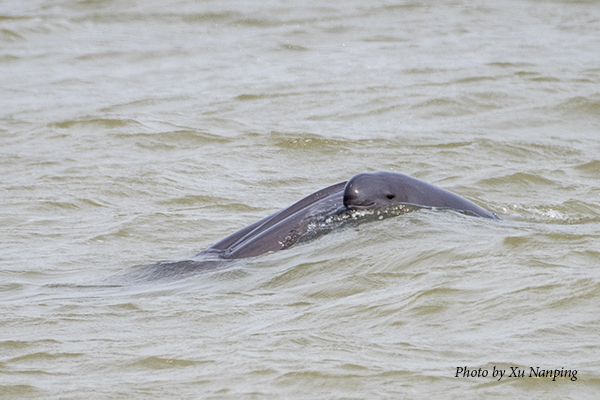
“The water level of the lake went down too fast. We all worry that the Yangtze finless porpoise may be stranded in shallow waters,” Pan said.
On Sept 23, when Pan patrolled the lake with his colleagues, the tips of some submerged rocks had been found above the surface of the water, which suggests that the porpoise may strand at any time. Since then, instead of patrolling the lake twice a week as they previously did, they have chosen to stay on duty around the clock. Aside from patrolling personally, they also resort to drones to help watch over the animal to ensure that no porpoise will get into trouble without being found.
“Our eight colleagues work on two shifts. At the very beginning, we ate and lived on a boat, though we built makeshift houses on the shore area some days later,” Pan said.
On dog days, the sun shining on the shore area made us dizzy. At night, we had to suffer the mosquito. It was so hot and stuffy that we sometimes failed to fall asleep for a whole night, he added.
In October, the sharp decreases in the temperature and the wind from the lake often made us tremble, as we didn’t have time to return home to bring some thick clothes. We work on shift for over 20 days and nights. During that time, we always ate instant noodles. We found it increasingly difficult to swallow the noodles.
Despite the difficulties, Pan and his colleagues have never thought about quitting. “We are guards of the Yangtze finless porpoise! As long as the water level does not rise to the level that is completely safe for them, we will not stop patrolling around the clock,” he said resolutely.
Also in the Piaoyatou area, Zhan Boshan from the law enforcement team for fishing management from Changdu County shoulders up another important task.
Because of the large concentration of Yangtze finless porpoise in the area, they not only face the risk of being stranded but also food shortages. Following thorough discussions with experts and their careful arrangement, Zhan led over 30 fishermen to the area to help dozens of the porpoise to migrate on November 4.
After accepting the task, all of them took it very seriously. They surveyed the area for two days with the help of various apparatus. Aside from metering the speed of water flow and the depth of the water, they prepared nets with big and small meshes.
Before they went into action, they designated specific people for certain tasks, including driving the boat, casting the fishing net, capturing, transportation and medical care. To avoid the porpoise from being injured by the fishermen’s fingernails, those tasked to pick up the animal were all asked to cut their nails as much as possible.
In the operation, once a porpoise was picked up, they were immediately put onto a stretcher and then sent to a water tank by men with strong strength so that the breath of the animal would not be affected.
There were some experts standing by. They sized the time to check the health conditions of every porpoise to ensure that they would be transported to the area with deep water safe and sound.
“The great difficulty in the work is to make them gather together. We spent over 20 days completing the task,” Zhan said. Once their persistent efforts that lasted for a whole day ended in vain. Because of the turbulent water, the hungry and tired team saw a porpoise escape from the net they had meticulously cast.
“Do you think the effort is worth it?” we asked.
“It is worth it! We hope that our future generations can also see the Yangtze finless porpoise. We should unswervingly prevent it from becoming just a legend.” Zhan answered without any hesitation.
There are now 203 teams of fishing management in Poyang Lake. Many of them are just like Pan and Zhan. They safeguard the “smiling angel” silently.
The preliminary results from the 2022 scientific investigations for the Yangtze finless porpoise, which was organized by the Ministry of Agriculture and Rural Affairs show that the porpoise has seen its wild population rise from 1,012 in 2017. The number of the animals went up obviously in the Hukou sections of the Yangtze and some other sections. What’s more, more mother and baby porpoises have been spotted, indicating that the species’ population is in a direction to further recovery.
Treat the guests from far away well
“How many birds are there in Poyang Lake? When they fly, you cannot see the clouds and the moon. When they land, they cover all the grass in the shore area,” as a saying goes.
It was a sunny day on December 9. During the day, over 50,000 migratory birds were resting in the rice fields of the Chaqi branch of Kangshan farm in Yugan County. They shook their wings, combed their feather and lowered their heads to search for food. They, together with the blue sky and the beautiful Daming Lake, one of the plate-shaped water areas in the Poyang Lake that comes into being every dry season after water levels go down, comprised a vivid and harmonious ecological picture.
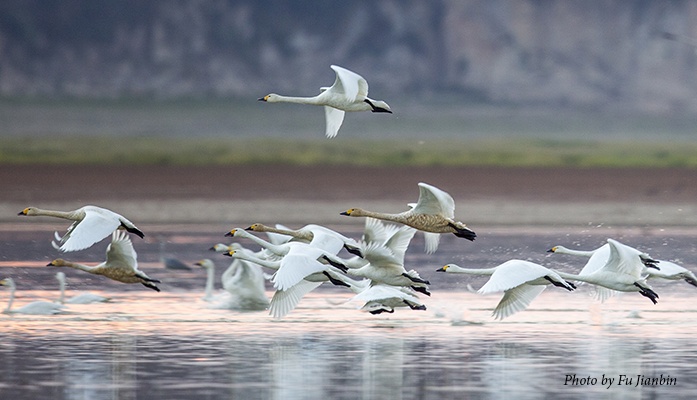
“These little birds are smart! The terrible drought in Poyang Lake left many fish, shrimp, snails and clams dead. Compared with last year, the number of migratory birds coming to winter went up by 20,000. They came 10 days ahead of the usual time. There are now almost 2,000 Siberian Cranes, over 500 Oriental storks, and more than 400 swans. With almost 50,000, wild goose outpaced all other birds in number. There are also some grey cranes,” said Zhang Keshun, a ranger with the Poyang Lake wetland ecological protection center of Yugan county.
Zhang was asked to devote himself to the patrolling mission 15 days earlier than the usual time. To timely find injured migratory birds, he has patrolled more frequently than he did last year. In 2021, he patrolled the Daming Lake once every seven to 10 days. Now he patrols once and even twice a day.
Several days ago, a resident from a nearby village sent an injured swan to him. Zhang fed him rice. He found, however, the swan failed to notice his moving hands at all. “There must be something wrong with its eyes. I called the county forestry administration immediately and then sent it to the administration for treatment,” he told us.
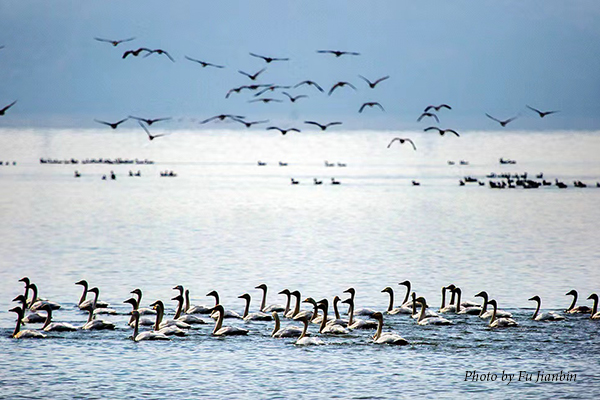
To ensure that migratory birds can winter in the area safe and sound, the Yugan government paid farmers to leave the rice they planted in about 1,000 mu (67 hectares) of field so that they can work as a “canteen” for the birds. Fifty mu of the rice belong to Zhang. For that, he was compensated more than 60,000 yuan. If he harvested the rice to sell, he expects he could pocket another 3,000 yuan. But he didn’t complain about the loss at all.
“It doesn’t matter. I consider that as treat for guests from far away,” he said.
In Duchang county natural reserve for migratory birds, which is over 100 kilometers away from Yugan, Li Yue, head of the reserve administration is resorting to another approach to protect the migratory birds.
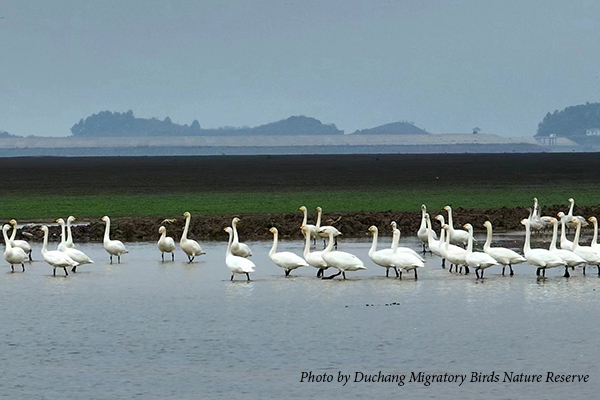
Duchang is an important wintering area for migratory birds in the northern part of Poyang Lake. Several plate-shaped water areas that saw a large number of migratory birds last year dried up much earlier than in normal years.
“The plate-shaped water areas boast rich biodiversity resources and are paradises for migratory birds. To enliven the plate-shaped water areas, we have been busy for several months,” he said.
In late September, after figuring out the conditions in the plate-shaped water areas that saw large flocks of migratory birds in previous years, they carried out ecological water supplementation in a plate-shaped water area near Zhupao mountain to remediate it, which is close to the shipping lane of the Poyang Lake and has a good condition for water diversion.
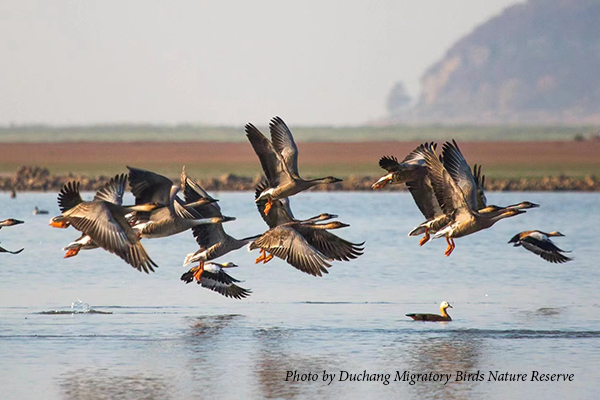
“As an almost natural approach, the so-called ecological water supplementation is to build dikes with soil other than cement and steel bars to help divert water into the plate-shaped water area before the arrival of large flocks of migratory birds,” Li told us.
He said the plate-shaped water area near Zhupao mountain once shrank to only over 300 mu. To supplement water to it, four high-power pumps worked around the clock to divert water via an almost 200-meter channel they built.
“To ensure that all emerging problems could be timely addressed in the water diversion operation, some patrollers lived in tents they put up on an island covered by grass for dozens of days,” he recalled.
Almost two months later, the water supplemented to the plate-shaped water area near Zhupao mountain reached over 400,000 cubic meters. Thanks to the supplementation, the water level in the area rose by over 40 centimeters, and its surface area expanded to more than 800 mu. On November 4, they released almost 2,000 kilograms of fish fries into the area.
On November 28, over 90,000 migratory birds were found to have come to winter in Changdu. The plate-shaped water area near Zhupao mountain received over 3,000 migratory birds, including Siberian Cranes, Hooded Cranes, White-naped Cranes and Oriental Stork.
To make the guests from far away feel like they are just at their homes, Jiangxi province has supplemented a total of 6.1 million cubic meters of water to plate-shaped water areas in Poyang Lake this year. A total of 130,000 mu of old marsh grass have been mowed, 5,370 mu of “canteen” have been set, and 51,000 kilograms of grains have been reserved as food for migrator birds.
The crane dance in Poyang Lake. Thousands of birds fly happily. The scenery is as beautiful as it was.
Safeguard coward wild animal “friends”
“Look! The infrared camera we set on an island covered by grass captured the image of a water deer.”
On December 5, in the building of the College of Life Sciences, Jiangxi Normal University Professor Li Yankuo, an expert on water deer, showed up pictures of the animal very excitedly.
As many areas in the Poyang Lake dried up earlier than normal years, the marsh grass sprouted too early and has soon grown too old. To ensure that there is enough tender grass for Anatidae migratory birds to eat, the Jiangxi forestry department rolled out operations to mow the marsh grass.
“We fixed six infrared cameras in a location where the marsh grass has been mowed. We didn’t expect that they captured images of water deer that came to seek food just on the second day. On November 23, they captured water deer again,” he said.
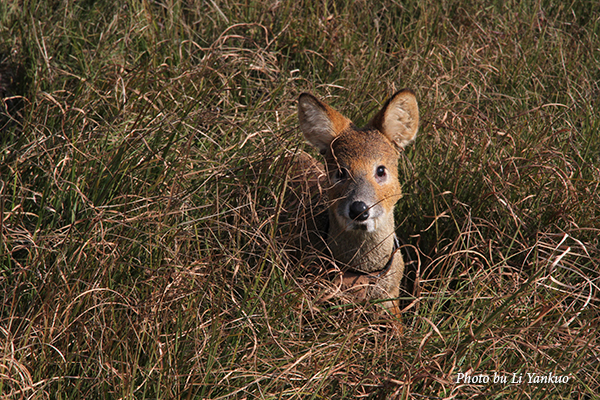
Water deer are under grade two national protection. In the wet season, they live in the forest. In the dry season, they come back to the wetland. It’s a major index species for wetlands. Poyang Lake is one of the major distribution areas for water deer. Among wild animals that are endemic to wetlands in Poyang Lake, water deer is the land animal under the highest level of protection. Statistics in 2021 show that there are over 2,300 water deer in Poyang Lake.
What makes Li worry is that the water deer is very cowardly. Once shocked, they will run in all directions to escape. Originally, they liked islands covered by marsh grass, as such islands can offer them food and shelter. The finding of water deer in areas where the marsh grass has been mowed indicates that the drought has changed their living environment.
“Failing to find enough food, they have no choice but to take the risk to seek food here and there,” he said.
Li started to research water deer in 2015. Joining hands with the office of the demonstration program for wetland protection systems of the Global Environment Facility in Jiangxi province, he carried out surveys for water deer in Poyang Lake three times in May 2020, March 2021 and September 2021. He also released nine artificially bred water deer back into nature.
With help of satellite positioning facilities, he found that the number of water deer is rising quickly because of the increasingly intensified efforts to protect species in the Poyang Lake and the decreasing poaching activities.
Actually, though water deer is not as noted as the Yangtze finless porpoise and Siberian Crane, the protection of the animal has been a key part of the work of the administration for Jiangxi Poyang Lake National Natural Reserve.
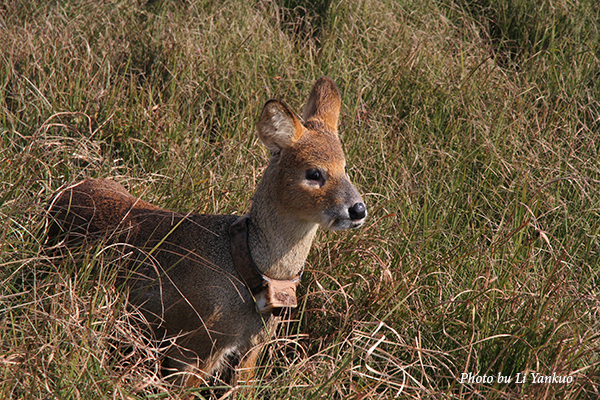
On October 20, the administration rolled out the first survey for water deer in the dry season in 2022. Based on a survey approach that combines sample plot investigation and infrared camera monitoring, the administration has managed to figure out the distribution areas of the water deer and its population. The work is expected to offer scientific support for the administration to hammer out further plans to protect the species.
In accordance with monitoring in recent years, Li has recently completed a plan for the monitoring and protection of water deer. He has included his suggestions in the plan: to carry out regular monitoring, enhance publicity for the animal’s protection, set up zones where hunting is forbidden and also an annual effective period for the ban and roll out joint governance with local communities to bring the water deer under scientific and effective protection.
The smile of the Yangtze finless porpoise, the singing of the migratory birds that come to winter, the image of the smart water deer, as well as many other grass and trees, rare poultry and animals. All of them have demonstrated the beauty of rich biodiversity.
This is our Poyang Lake, a water body that brings people tender feelings and the beauty of which can hardly be described. This is the poetic homeland we inhabit together…
This is the significance of our efforts to safeguard it.
